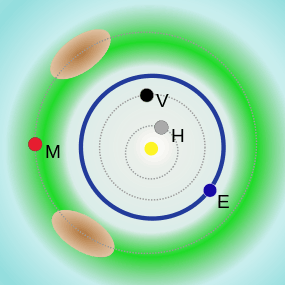5751 Zao
| Discovery[1] | |
|---|---|
| Discovered by | M. Koishikawa |
| Discovery site | Ayashi Station |
| Discovery date | 5 January 1992 |
| Designations | |
| MPC designation | 1992 AC |
Named after | Mount Zaō |
| MPO 319156, 1989 EN1 | |
Amor  NEO | |
| Orbital characteristics[2] | |
| Epoch 13 January 2016 (JD 2457400.5) | |
| Uncertainty parameter 0 | |
| Observation arc | 9792 days (26.81 yr) |
| Aphelion | 2.994076221 AU (447.9074274 Gm) |
| Perihelion | 1.21174819 AU (181.274949 Gm) |
| 2.102912204 AU (314.5911880 Gm) | |
| Eccentricity | 0.423776140 |
| 3.05 yr (1113.9 d) | |
| 300.120144° | |
| 0° 19m 23.523s / day | |
| Inclination | 16.0739405° |
| 121.691193° | |
| 25.2587992° | |
| Earth MOID | 0.244159 AU (36.5257 Gm) |
| Jupiter MOID | 2.07687 AU (310.695 Gm) |
| Jupiter Tisserand parameter | 3.581 |
| Physical characteristics | |
| Dimensions | 2.3 km[3] |
Mean radius | 1.15 km |
| 76 h (3.2 d)[3] | |
| 0.36[3] | |
| 14.8 | |
|
| |
5751 Zao also designated 1992 AC is an Amor asteroid discovered on January 5, 1992 by M. Koishikawa at the Ayashi Station of the Sendai Astronomical Observatory.
Physical properties
5751 Zao has been observed by several groups to determine its rotational period. Its light curve was observed by Pravec, et al. between 1992 and 1995 with the intention of determining its rotational period. From its nearly constant brightness it was determined that the asteroid is roughly spherical and has a rotational period of ≥ 21.7 hr.[4] Another group led by Wisniewski conducted an approximately 5 hour observation and were unable to conclude a rotational period.[5] 5751 Zao was again observed in 2001 by Delbó, et al. using the Keck telescope. They were able to determine the asteroid's albedo of 0.36 and re-classify the asteroid from X-type to E-type.[6] Using the asteroid's albedo and the Near Earth Asteroid Thermal Model (NEATM) the asteroid's diameter was estimated to be 2.3 km.[6] Further study of the asteroid by the Ondrejov Asteroid Photometry Project concludes that a rotational period of 76 hours is consistent with earlier measurements.[3][7]
References
- ↑ "(5751) Zao = 1992 AC = 1989 EN1". Minor Planet Center. Retrieved 2015-06-04.
- ↑ "5751 Zao (1992 AC)". JPL Small-Body Database. NASA/Jet Propulsion Laboratory. Retrieved 13 April 2016.
- 1 2 3 4 "5751 Zao". European Asteroid Research Node.
- ↑ Pravec, P.; et al. (December 1997). "The Near-Earth Objects Follow-Up Program". Icarus. 130 (2): 275–286. Bibcode:1997Icar..130..275P. doi:10.1006/icar.1997.5816.
- ↑ Wisniewski, W. Z.; MichaŁowski, T. M.; Harris, A. W.; McMillan, R. S. (April 1997). "Photometric Observations of 125 Asteroids". Icarus. 126 (2): 395–449. Bibcode:1997Icar..126..395W. doi:10.1006/icar.1996.5665.
- 1 2 Delbó, Marco; Harris, Alan W.; Binzel, Richard P.; Pravec, Petr; Davies, John K. (November 2003). "Keck observations of near-Earth asteroids in the thermal infrared". Icarus. 166 (1): 116–130. Bibcode:2003Icar..166..116D. doi:10.1016/j.icarus.2003.07.002.
- ↑ "Ondrejov Asteroid Photometry Project: Summary of Prepublished Data".
External links
- IAUC 5426 - Initial discovery
- IAUC 5442 - Refined orbital elements
- IAUC 5474 - Extension to ephemeris
- 5751 at the JPL Small-Body Database
